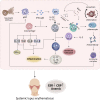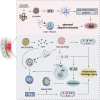The role of inflammation in autoimmune disease: a therapeutic target
- PMID: 37859999
- PMCID: PMC10584158
- DOI: 10.3389/fimmu.2023.1267091
The role of inflammation in autoimmune disease: a therapeutic target
Abstract
Autoimmune diseases (AIDs) are immune disorders whose incidence and prevalence are increasing year by year. AIDs are produced by the immune system's misidentification of self-antigens, seemingly caused by excessive immune function, but in fact they are the result of reduced accuracy due to the decline in immune system function, which cannot clearly identify foreign invaders and self-antigens, thus issuing false attacks, and eventually leading to disease. The occurrence of AIDs is often accompanied by the emergence of inflammation, and inflammatory mediators (inflammatory factors, inflammasomes) play an important role in the pathogenesis of AIDs, which mediate the immune process by affecting innate cells (such as macrophages) and adaptive cells (such as T and B cells), and ultimately promote the occurrence of autoimmune responses, so targeting inflammatory mediators/pathways is one of emerging the treatment strategies of AIDs. This review will briefly describe the role of inflammation in the pathogenesis of different AIDs, and give a rough introduction to inhibitors targeting inflammatory factors, hoping to have reference significance for subsequent treatment options for AIDs.
Keywords: B cells; T cells; autoimmunity; inflammation; pro-inflammatory factors.
Copyright © 2023 Xiang, Zhang, Jiang, Su and Shi.
Conflict of interest statement
The authors declare that the research was conducted in the absence of any commercial or financial relationships that could be construed as a potential conflict of interest.
Figures








Similar articles
-
Glycolysis in Innate Immune Cells Contributes to Autoimmunity.Front Immunol. 2022 Jul 1;13:920029. doi: 10.3389/fimmu.2022.920029. eCollection 2022. Front Immunol. 2022. PMID: 35844594 Free PMC article. Review.
-
Macrophages: The Good, the Bad, and the Gluttony.Front Immunol. 2021 Aug 12;12:708186. doi: 10.3389/fimmu.2021.708186. eCollection 2021. Front Immunol. 2021. PMID: 34456917 Free PMC article. Review.
-
Volatile organic compounds: A proinflammatory activator in autoimmune diseases.Front Immunol. 2022 Jul 29;13:928379. doi: 10.3389/fimmu.2022.928379. eCollection 2022. Front Immunol. 2022. PMID: 35967306 Free PMC article. Review.
-
From autoinflammation to autoimmunity: old and recent findings.Clin Rheumatol. 2018 Sep;37(9):2305-2321. doi: 10.1007/s10067-018-4209-9. Epub 2018 Jul 16. Clin Rheumatol. 2018. PMID: 30014358 Review.
-
Atherosclerosis and autoimmunity: a growing relationship.Int J Rheum Dis. 2018 May;21(5):908-921. doi: 10.1111/1756-185X.13309. Epub 2018 Apr 19. Int J Rheum Dis. 2018. PMID: 29671956 Review.
Cited by
-
Putting Functional Gastrointestinal Disorders within the Spectrum of Inflammatory Disorders Can Improve Classification and Diagnostics of These Disorders.Biomedicines. 2024 Mar 21;12(3):702. doi: 10.3390/biomedicines12030702. Biomedicines. 2024. PMID: 38540315 Free PMC article. Review.
-
Comparison of Metabolic Syndrome, Autoimmune and Viral Distinctive Inflammatory Related Conditions as Affected by Body Mass Index.J Clin Med. 2024 Oct 22;13(21):6298. doi: 10.3390/jcm13216298. J Clin Med. 2024. PMID: 39518437 Free PMC article.
-
Uncovering the Causal Link Between Obesity-Associated Genes and Multiple Sclerosis: A Systematic Literature Review.Brain Behav. 2025 Apr;15(4):e70439. doi: 10.1002/brb3.70439. Brain Behav. 2025. PMID: 40195065 Free PMC article.
-
Yoga Practice as a Potential Sarcopenia Prevention Strategy in Indonesian Older Adults: A Cross-Sectional Study.Open Access J Sports Med. 2025 Jan 10;16:3-13. doi: 10.2147/OAJSM.S494489. eCollection 2025. Open Access J Sports Med. 2025. PMID: 39816476 Free PMC article.
-
Circulating Brain-Reactive Autoantibody Profiles in Military Breachers Exposed to Repetitive Occupational Blast.Int J Mol Sci. 2024 Dec 21;25(24):13683. doi: 10.3390/ijms252413683. Int J Mol Sci. 2024. PMID: 39769446 Free PMC article.
References
Publication types
MeSH terms
Substances
LinkOut - more resources
Full Text Sources
Medical

